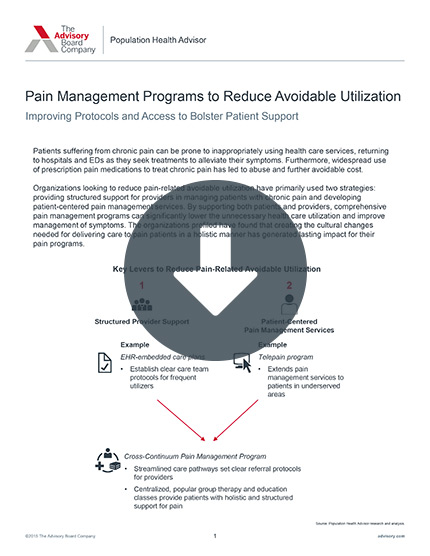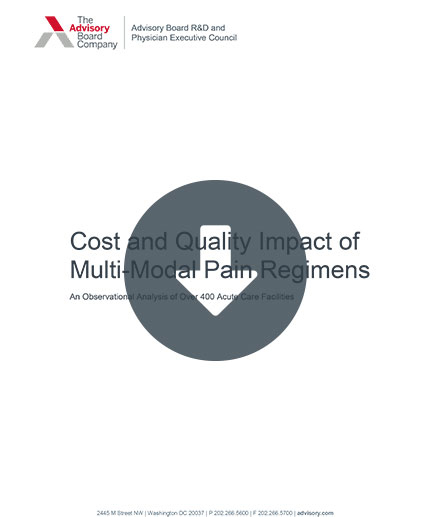Amid the opioid epidemic, more patients and providers are turning to biopsychosocial pain management—an approach that empowers patients to manage pain with physical therapy, biofeedback, meditation, and other alternatives to opioids, Meghana Keshavan writes for STAT News.
What’s trending in surgical services?
But the treatment can take several weeks and cost thousands of dollars, Keshavan writes. And while it has been proven successful in some studies, insurers remain reluctant to cover it. "We've been banging our heads on the wall, and banging our fists on the door, trying to get insurers to pay for this," Bob Twillman, executive director of the Academy of Integrative Pain Management. "For the most part, they will not."
Pain as a physical and emotional experience
According to the American Pain Foundation, nearly 50 million Americans experience chronic pain, largely driven by migraines, arthritis, or nerve damage. But chronic pain isn't just physical, Keshavan writes—it frequently involves emotional trauma. That psychological element can lead to self-imposed isolation, which in turn spurs feelings of anxiety, depression, and the catastrophization of pain.
Soon enough, Keshavan writes, the patient can think only of his or her pain. In fact, this psychological element might be why using medical treatment to address the initial cause of the pain is unlikely to resolve the patient's broader concern. For instance, she cites data from the American Academy of Pain Medicine that found only 58 percent of patients who take prescription painkillers said the drugs effectively treated their pain.
Jeannie Sperry, a psychologist who co-chairs the division of addictions, transplant, and pain at Mayo Clinic, explained that when the body experiences acute pain, the peripheral nervous system—which generates the feeling of pain—sends signals to the brain, warning of danger. At that point, the brain will assess whether to process the signals or reject them. However, among patients experiencing chronic pain, that "system has gone awry," Sperry said. And "without training your brain to turn down the alarm system, the alarm keeps going off all the time."
That's why patients who initially experience pain in one part of their bodies—an arm or foot, for instance—might eventually have a range of other physical symptoms, such as migraines, fatigue, and nausea, Keshavan writes. "Focusing solely on a pain generator in the body," such as nerve damage, "utterly and completely misses the chronic, complex, changing nature of chronic pain" as it's interpreted by the brain, Tracy Jackson, an associate professor of anesthesiology and a pain specialist at Vanderbilt University, explained.
Nonetheless, according to Keshavan, opioids remain the go-to treatment for chronic pain. And while the drugs are often quick and efficient in many ways, they are highly addictive. As of 2014, 2.5 million adult Americans misused opioids, many of which began with a prescription painkiller, Keshavan writes.
A not-so-new form of pain management
Spurred by this growing epidemic, more providers and patients are turning to biopsychosocial pain management, Keshavan reports.
It's not a new idea, Keshavan writes. In fact, there used to be several hundred integrative pain facilities throughout the United States. But after OxyContin hit the market in 1996—quickly becoming the method of choice for addressing pain—the overall number of integrative pain facilities dwindled to just four: Mayo Clinic, Johns Hopkins University, Cleveland Clinic, and Stanford University. Now, however, the number is inching back up.
According to Keshavan, the Mayo Clinic program runs for three weeks on an 8 a.m. to 5 p.m. schedule. Over the course of the program, patients participate in physical and occupational therapy, learning techniques to avoid exacerbating their pain during everyday activities, as well as spending between four and five hours per day learning to understand their pain. These sessions include deep breathing exercises, meditation, relaxation techniques, and self-assessment about the psychological underpinnings of their pain.
Research suggests the methods are helpful, Keshavan writes. For instance, the Brooks Rehabilitation pain program found that after six months of treatment, 90 percent of patients said their quality of life had improved, and 75 percent said their pain had decreased. Moreover, only 6 percent of patients who were weaned off of opioids over the course of the program began taking them again afterward.
Meanwhile, a study in Pain found that many of the 339 patients who completed Mayo's three-week program said the severity of their pain and level of their depression had decreased, while their social functioning had improved. Those improvements were consistent between patients who had been taking opioids before they began treatment and those who had not, Keshavan adds.
A cultural shift
But the programs can be costly, Keshavan writes. Mayo Clinic's program costs between $37,000 to $42,000 for three weeks, while other, less intense versions of the program elsewhere cost between $4,000 and $10,000.
And despite the evidence suggesting the programs' efficacy, insurers still prefer to pay for pharmaceuticals rather than approaches such as therapy, meditation, and massage, Keshavan reports. "It's much more efficient for insurers to pay for a pill in a 15-minute office visit," Twillman said, "instead of a pill, plus a psychologist, plus a chiropractor, plus acupuncture, plus yoga and massage."
However, Keshavan writes that amid the opioid epidemic, that resistance is fading. For instance, FDA just updated its provider education guidelines to encourage physicians to learn about alternative therapies for pain management. And insurers are indicating a new willingness to cover wide-ranging approaches: Oregon's Medicaid system has started covering more physical therapy and chiropractor visits; Cigna has bolstered its coverage for back pain physical therapy; and Veterans Affairs has started encouraging chronic pain patients to meditate, attend cognitive behavior therapy, and increase their physical activity.
And Sperry is reaching out to medical students via a Mayo Clinic program that teaches participants how to say "no" to patients seeking more opioids—and instead direct them to alternative methods for managing pain. "We need a cultural shift," said Sperry. "There's an implication that there's a pill for everything—and that's not accurate. It's very dangerous" (Keshavan, STAT News, 5/30).
What’s trending in surgical services?
Want the latest information for your next surgical services meeting? We updated our most popular slides on general surgery with the latest market trends. This ready-to-use presentation covers everything from growth outlook and financial considerations to new care management priorities and technology innovations.
Use the 2017 slides to frame your next strategy meeting and build a strong foundation for your presentation.
Don't miss out on the latest Advisory Board insights
Create your free account to access 2 resources each month, including the latest research and webinars.
Want access without creating an account?
You have 2 free members-only resources remaining this month remaining this month.
1 free members-only resources remaining this month
1 free members-only resources remaining this month
You've reached your limit of free monthly insights
Become a member to access all of Advisory Board's resources, events, and experts
Never miss out on the latest innovative health care content tailored to you.
Benefits include:
You've reached your limit of free monthly insights




